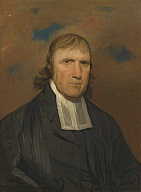
I have been spent many an hour recently swimming in the great sea of genealogy at Ancestry. For much of that time I was exploring the roots and branches of the descendants of Dr. Joseph Speed, a prominent early settler of Caroline. Henry Linn Speed was the son of James Richard Speed (1815–1864) of Slaterville and Frances Peters of Philadelphia (1818–1901). (James was the son of Dr. Speed.) When I read in his obituary that he was the great nephew of Mrs. Simeon De Witt, I decided to find the details of this connection.

Henry's mother was born in Philadelphia to John W. Peters (1789–1830) and Sarah Livingston Linn (1793–1840). How does a guy living in Slaterville meet and marry a woman from Philadelphia?

Sarah Livingston Linn, Henry's grandmother, was the daughter of William Adolphus Linn (1752–1808) and Rebecca Blair (1754–1794). Her father was a famous preacher and theologian. and the first chaplain of the House of Representatives. He was involved in institutions of higher learning, serving as a trustee and president of Queen's College, now Rutgers, and for 21 years as a regent of the University of the State of New York. At some time after 1793 Dr Linn moved his family from Shippensburg, Pennsylvania, to Albany, New York.
Among the other university regents William Linn would have met fellow Albany citizen, the Surveyor General of the State of New York and founder of the village of Ithaca, Simeon De Witt. It's not hard to imagine that in the normal course of social activity Simean met Susan Linn (1798–1824), Sarah's sister. In 1810 they were married in Greenwich, New York.
While the De Witts continued to live in Albany, Simeon's interests in Ithaca were entrusted to Susan's brother, William Linn, who arrived around 1812. In 1816 he married Mary Ann Beers or Biers. They had a daughter Susan Elizabeth (1819–1885), who married the Henry Sage of Cornell fame. William Linn wrote a well-received biography of Thomas Jefferson. He belonged to the Locofoco party, and was the dirty trickster behind the Roerbach Hoax of 1844 (The History of the Four Counties, p. 402), intended to derail the presidential candidacy of James K. Polk by accusing him of being a slave holder.
Over the course of the next decade, William Linn proved to be a poor advocate of De Witt's interests and a detriment to his reputation. "Linn, for whom Linn Street is named, began mixing his financial affairs with those of DeWitt's. Even worse, he proved to be too lax, writing contracts without clear obligations on the part of the lessee, neglecting to hold people to the terms of their contracts, and failing to collect rents and prosecute the delinquents." (Simeon DeWitt: Founder of Ithaca, p. 28) In 1822 De Witt replaced him with Frances Bloodgood. In 1823 Susan Linn De Witt published a novel, Justina, or The Will. Early in the book the heroine's father, a merchant in New York, is deceived by his agents in London, where "he found his affairs in a worse condition than he had even feared. Many of those he had employed had been faithless to their trust; and while they had enriched themselves at his expense, had injured his fame to shield their own."
I didn't find a precise answer to how James Speed of Slaterville met Frances Peters of Philadelphia. However, I have established that the children and grandchildren of William Linn had reasons to visit Ithaca. Even though Simeon and Susan DeWitt were dead before 1838, Frances' uncle William and cousin, Susan Sage, were still alive. It doesn't seem improbable that Frances visited Ithaca, where she could have met James Speed, a member of a prominent local family. They married in 1838 and had seven children, among them Henry Linn Speed, the great nephew of Mrs Simeon De Witt. QED.
Simeon DeWitt came from a distinguished family. One first cousin, Moses De Witt, surveyed the military tract township of Ulysses, which was later divided into the towns of Ithaca, Ulysses, and Enfield, and the city of Ithaca. The town of De Witt, New York, was named after Moses. Another first cousin, DeWitt Clinton (his mother was Mary De Witt, sister of the fathers of Simeon and Moses), became mayor of New York City, governor of the state, and the man behind the Erie Canal. A third first cousin, Margaret De Witt, married Garrett Mandeville in 1799. They moved to Caroline in 1804, where Garrett organized one of the earliest churches in the town. Although the church building is now gone, the graveyard has survived, across Slaterville Road from the Caroline School.

Pingback: Fatal Runaway Accident – Town of Caroline History